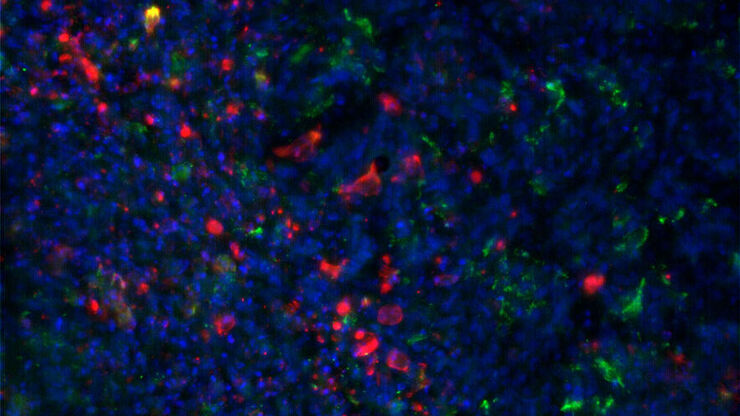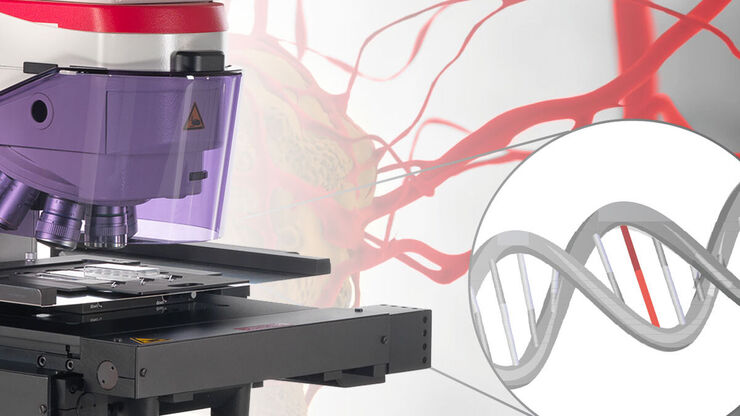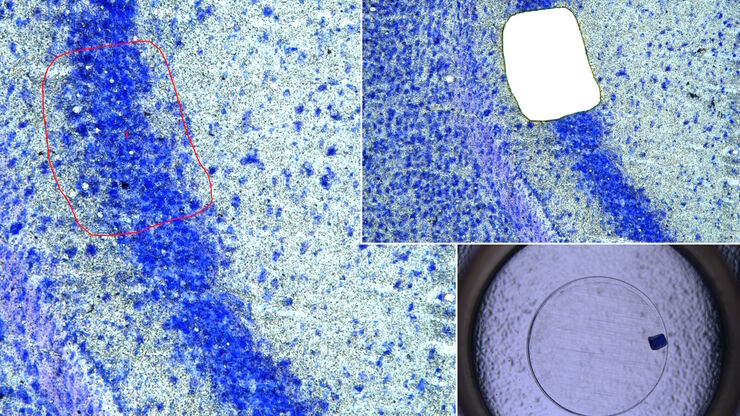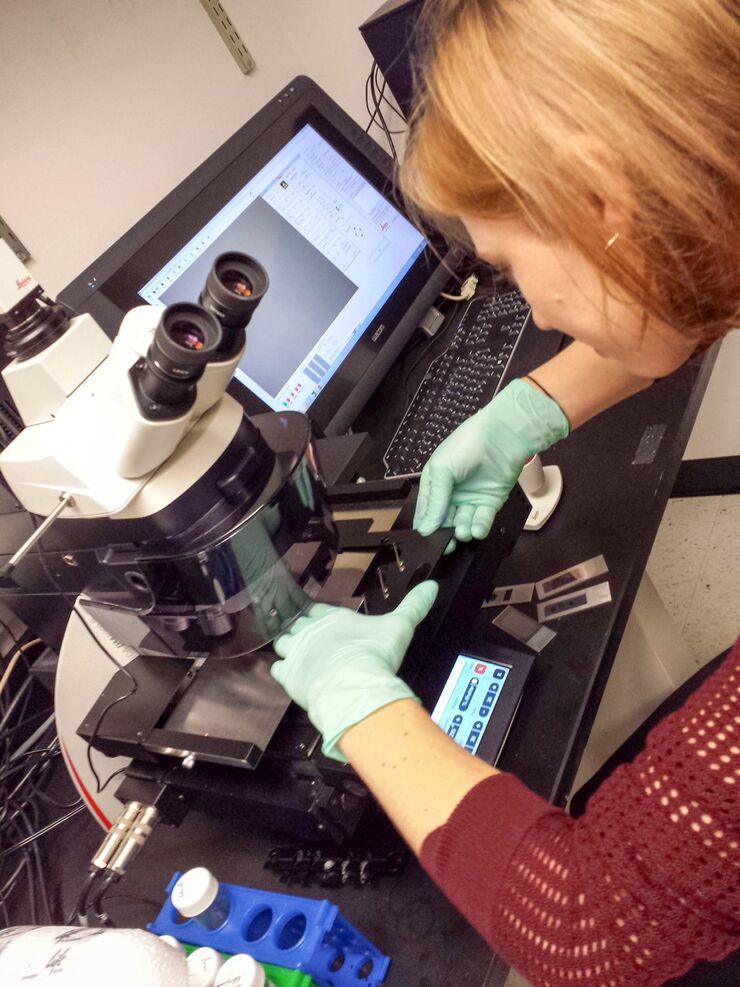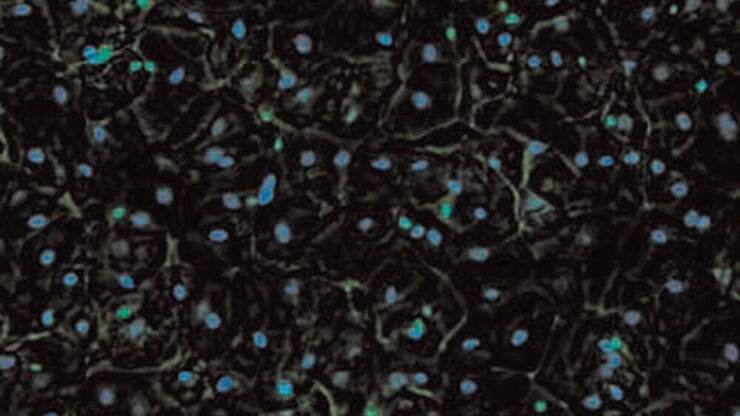Leica LMD6 & LMD7
正置显微镜
复合光学显微镜
产品
首页
Leica Microsystems
Leica LMD6 & LMD7 激光显微切割
出色切割
阅读我们的最新文章
病毒学
您的主要研究对象是病毒感染和疾病吗? 了解如何使用徕卡显微系统公司的成像和样本制备解决方案深入研究病毒学。
组织中的精密空间蛋白质组学信息
尽管可使用基于成像和质谱的方法进行空间蛋白质组学研究,但是图像与单细胞分辨率蛋白丰度测量值的关联仍然是个巨大的挑战。最近引入的一种方法,深层视觉蛋白质组学(DVP),将细胞表型的人工智能图像分析与自动化的单细胞或单核激光显微切割及超高灵敏度的质谱分析结合在了一起。DVP在保留空间背景的同时,将蛋白丰度与复杂的细胞或亚细胞表型关联在一起。
An Introduction to Laser Microdissection
The heterogeneity of histological and biological specimens often requires isolation of specific single cells or cell groups from surrounding tissue before molecular biology analysis can be carried…
激光微切割(LMD)促进的分子生物学分析
使用激光微切割(LMD)提取生物分子、蛋白质、核酸、脂质和染色体,以及提取和操作细胞和组织,可以深入了解基因和蛋白质的功能。它在神经生物学、免疫学、发育生物学、细胞生物学和法医学等多个领域有广泛应用,例如癌症和疾病研究、基因改造、分子病理学和生物学。LMD 也有助于研究蛋白质功能、分子机制及其在转导途径中的相互作用。
空间代谢组学:探索肿瘤复杂性和治疗见解
在癌症研究中,理解肿瘤细胞与其微环境之间的相互作用至关重要,因为肿瘤微环境显著影响肿瘤进展。空间代谢组学是一种由研究人员开发的新方法,用于研究这一复杂性。通过揭示肿瘤微环境中的空间变化,该方法提供了对其多样化成分及其组织的宝贵见解。这些见解不仅影响临床结果,还为治疗反应提供信息,为个性化治疗策略铺平道路。
基于激光显微切割的稀疏细胞脂质组学分析
通过高覆盖率靶向脂质组学分析稀疏细胞,深入探讨细胞复杂性。这种先进的方法结合了激光显微切割(LMD)和液相色谱-质谱/质谱(LC-MS/MS),揭示了单细胞水平的代谢变化,阐明了糖尿病和肥胖等疾病。通过采用激光显微切割(LMD)获得无污染样本,并使用 SCIEX 7500 系统提高灵敏度,该方法成功检测到 285…
利用激光显微切割(LMD)在空间背景下分离神经元
在阿尔茨海默病之后,帕金森病是第二常见的进行性神经退行性疾病。在首发症状出现之前,中脑中高达70%的多巴胺释放神经元已经死亡。本文描述了如何使用现代激光显微切割(LMD)方法帮助解决帕金森病之谜。研究涉及在空间背景下分离和分析神经元。这些细胞来自帕金森病患者的死后黑质组织样本,以便深入了解该病的分子机制。
激光显微切割技术如何助力神经科学研究取得开创性进展?
玛尔塔·帕特林尼博士,卡罗林斯卡学院的高级科学家,分享了她在成人人类神经发生开创性研究中使用激光显微切割(LMD)的经验,并提供了关于LMD在空间蛋白质组学和精准医学中未来应用潜力的个人见解。
激光显微切割技术用于组织和细胞分离的协议 - 免费下载电子书
激光显微切割(LMD,也称为激光捕获显微切割或LCM)使用户能够分离特定的单个细胞或整个组织区域,甚至亚细胞结构如染色体。纯化的组织和细胞可用于下游的RNA、DNA和蛋白质组工作流程。
采用徕卡THUNDER-DM6B观察SARS-CoV-2感染宿主细胞及其复制过程
冠状病毒2致重度急性呼吸综合征(SARS-CoV-2)
冠状病毒2致重度急性呼吸综合征(SARS-CoV-2)出现于2019年末,并快速传播全世界。由于其大面积的影响,研究人员对病毒的性质进行了深入的研究以期最终阻止大流行。一个重要的方面是病毒如何在宿主细胞中复制。Ogando及其同事的研究已经揭示了SARS-CoV-2的复制动力学、适应能力和细胞病理学。他们的工具之一是用荧光显微镜观察SARS…
利用 SPARCS 探索亚细胞空间表型
功能日益强大的显微镜可提供信息丰富的各种细胞表型数据。如果与深度学习的最新进展相结合,这将成为在基因筛选中读出感兴趣的生物表型的理想技术。在本网络讲座中,您将了解到空间分辨 CRISPR 筛选 (SPARCS),这是一种利用自动化高速激光显微切割技术在人类基因组尺度上揭示各种亚细胞空间表型的平台。
空间生物学: 解析全景
空间生物学:了解分子、细胞和组织在原生空间环境中的组织和相互作用
显微镜如何应用在空间生物学中?一份显微镜指南
本电子书旨在探索显微镜中的关键空间生物学方法,例如多重成像技术,这个方法有助于将独立的细胞信息放入空间环境来分析。
Dissecting Proteomic Heterogeneity of the Tumor Microenvironment
This lecture will highlight cutting edge applications in applying laser microdissection and microscaled quantitative proteomics and phosphoproteomics to uncover exquisite intra- and inter-tumor…
20 Years of Leica Laser Microdissection
Phenotype-genotype correlations are key for insight. From Eye to Insight is therefore fitting perfectly to Leica Microsystems and in particular to laser microdissection. Laser Microdissection, also…
工作流程与协议:如何使用徕卡激光显微切割系统和 Qiagen 试剂盒进行成功的 RNA 分析
激光显微切割(LMD)允许分离单个细胞或染色体,是一种在下游分析核酸内容(通过 PCR 或测序技术)之前进行样本准备的成熟技术。在这里,我们描述了徕卡LMD系统与 Qiagen 试剂盒成功结合的过程,即使在少量样本中也能有效提取核酸。所呈现的工作流程和协议为成功的LMD应用提供了基础,确保在过程中不损失核酸数量,并保持 RNA 的完整性,突显了产品的高质量。
对性侵证据中的精子进行法医检测
现代科学方法对于犯罪现场证据分析的影响为法医学的多个子领域带来了极大的改变。最为引人注目的一个例子或许就是分子生物学对于生物证据分析的影响。
应用领域
公检法取证
作为一名法医科学家,显微镜和成像设备必须准确、优质、正确和可重复的结果,确保成功地检验证据。徕卡显微系统支持量化、分析和记录结果,从日常实验室到完整的自动化系统,提供各种法医显微镜解决方案。
